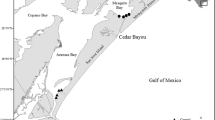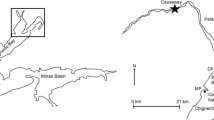Abstract
Packery Channel is part of a complex of storm washover channels which, before 1912, have opened intermittently, linking the Laguna Madre and Corpus Christi Bay, Texas with the Gulf of Mexico. On 21 July 2005, with the assistance of Hurricane Emily, Packery Channel was prematurely opened to the Gulf of Mexico, months before construction of a dredged channel was scheduled to be completed. A before-versus-after, control-versus-impact (BACI) design was used to assess the effects of reopening Packery Channel on water quality and estuarine macrofauna in Mollie Beattie Coastal Habitat Community (MBCHC), Corpus Christi Bay. Two deep (approximately 1 m below m.s.l.) and two shallow (approximately 0.2 m below m.s.l.) stations were sampled monthly for physical and biological characteristics at both control and impact sites between November 2003 and March 2009. The opening of Packery Channel created a unique situation where salinities decreased after the channel opening by ameliorating hypersalinity in Laguna Madre rather than increasing salinities as would occur in most estuaries worldwide. Salinity also fluctuated in a diurnal pattern after the opening of Packery Channel. Apart from salinity, Packery Channel has caused little hydrographic change in MBCHC since opening in July 2005. There was little effect on the macrofaunal community composition. There was a greater difference in community composition between deep and shallow stations than between either before and after or control and impact sites. There have been no significant changes in abundance, biomass, or N1 diversity caused by the opening of Packery Channel.









Similar content being viewed by others
References
Applebaum, S., Montagna, P. A., & Ritter, C. (2005). Status and trends of dissolved oxygen in Corpus Christi Bay, Texas, U.S.A. Environmental Monitoring and Assessment, 107, 297–311.
Ballard, B. M., Thompson, J. E., Petrie, M. J., Checkett, M., & Hewitt, D. G. (2004). Diet and nutrition of northern pintails wintering along the southern coast of Texas. Journal of Wildlife Management, 68, 371–382.
Brown, C. A., & Militello, A. (1997). Packery Channel feasibility study: bay circulation and water level, Report 2 of a 2-part series. Technical Report. TAMU-CC-CB1-96-07. Corpus Christi: Conrad Blucher Institute for Surveying and Science.
Buskey, E. J., Liu, H., Collumb, C., & Bersano, J. G. F. (2001). The decline and recovery of a persistent Texas brown tide algal bloom in the Laguna Madre Texas, USA. Estuaries, 24, 337–346.
Clarke, K. R. (1993). Non-parametric multivariate analyses of changes in community structure. Australian Journal of Ecology, 18, 117–143.
Clarke, K. R., & Ainsworth, M. (1993). A method of linking multivariate community structure to environmental variables. Marine Ecology Progress Series, 92, 205–219.
Clarke, K. R., & Gorley, R. N. (2006). PRIMER v6: user manual/tutoria. Plymouth: PRIMER-E. 190 p.
Clarke, K. R., & Warwick, R. M. (2001). Change in marine communities: an approach to statistical analysis and interpretation (2nd ed.). Plymouth: PRIMER-E. 859 p.
Cohen, J. B., & Fraser, J. D. (2010). Piping Plover foraging distribution and prey abundance in the pre-laying period. The Wilson Journal of Ornithology, 122, 578–582.
Colwell, M. A., & Landrum, S. L. (1993). Nonrandom shorebird distribution and fine-scale variation in prey abundance. The Condor, 95, 94–103.
D'Amico, V. L., & Bala, L. O. (2004). Prey selection and feeding behavior of the two-banded plover in Patagonia, Argentina. Waterbirds, 27, 264–269.
Drake, P., Arias, A. M., Baldó, F., Cuesta, J. A., Rodriguez, A., Silva-Garcia, A., et al. (2002). Spatial and temporal variation of the nekton and hyperbenthos from a temperate European estuary with regulated freshwater inflow. Estuaries, 25, 451–468.
Folk, R. L. (1964). Petrology of sedimentary rocks. Austin: Hemphill. 182 p.
Green, R. H. (1979). Sampling design and statistical methods for environmental biologists. New York: Wiley. 272 p.
Henley, D. E., & Rauschuber, D. G. (1981). Freshwater needs of fish and wildlife resources in the Nueces-Corpus Christi Bay area, Texas: a literature synthesis (410 p). Technical Report. FWS/OBS-80/10.-410. Washington: US Fish and Wildlife Service, Office of Biological Services.
Hill, M. O. (1973). Diversity and evenness: a unifying notation and its consequences. Ecology, 54, 427–432.
Huang, W., Sun, H., Nnaji, S., & Jones, W. K. (2002). Tidal hydrodynamics in a multiple-inlet estuary: Apalachicola Bay. Florida. Journal of Coastal Research., 18, 674–684.
Kalejta, B., & Hockey, P. A. R. (1991). Distribution, abundance and productivity of benthic invertebrates at the Berg River Estuary, South-Africa. Estuarine, Coastal and Shelf Science, 33, 175–191.
Kennish, M. J., Haag, S. M., Sakowicz, G. P., & Durand, J. B. (2004). Benthic macrofaunal community structure along a well-defined salinity gradient in the Mullica River Great Bay estuary. Journal of Coastal Research, 45, 209–226.
Kneib, R. T. (1992). Population-dynamics of the tanaid Hargeria rapax (Crustacea, Peracarida) in a tidal marsh. Marine Biology, 113, 437–445.
Koffi, K. P., Abe, J. A., & Kothias, J. B. (1991). Contribution to the study of the hydro-sedimentary modifications resulting from the artificial reopening of Comoe inlet at Grand-Bassam Cote d'Ivoire. Journal of Ivoirien D'Oceanologie et de Limnologie, 1, 47–60.
Komar, P. D. (1996). Tidal-inlet processes and morphology related to the transport of sediments. Journal of Coastal Research, 23, 23–45.
Kraus, N. C., & Heilman, D. J. (1997). Packery Channel feasibility study: inlet functional design and sand management, Report 1 of a 2-part series (106 p). Technical Report. TAMU-CC-CB1-96-07. Corpus Christi: Conrad Bluchner Institute for Surveying and Science.
Levin, L. A. (1984). Life history and dispersal patterns in a dense infaunal polychaete assemblage: community structure and response to disturbance. Ecology, 65, 1185–1200.
Livingston, R. J. (1991). Historical relationships between research and resource management in the Apalachicola River estuary. Ecological Applications, 1, 361–382.
Ludwig, J. A., & Reynolds, J. F. (1988). Statistical ecology: a primer on methods and computing. New York: Wiley. 368 p.
Mannino, A., & Montagna, P. A. (1997). Small-scale spatial variability of macrobenthic community structure. Estuaries, 20, 159–173.
Menzel, R. W., Hulings, N. C., & Hathaway, R. R. (1966). Oyster abundance in Apalachicola Bay, Florida, in relation to biotic associations influenced by salinity and other factors. Gulf Research Reports, 2, 73–96.
Michot, T. C., Woodin, M. C., & Nault, A. J. (2008). Food habits of redheads (Aythya Americana) wintering in seagrass beds of coastal Louisiana and Texas, USA. Acta Zoologica Academiae Scientiarum Hungaricae, 54(Suppl.1).
Milbrandt, E. C., Bartleson, R. D., Coen, L. D., Rybak, O., Thompson, M. A., DeAngelo, J. A., et al. (2012). Local and regional effects of reopening a tidal inlet on estuarine water quality, seagrass habitat, and fish assemblages. Continental Shelf Research, 41, 1–16.
Montagna, P., & Palmer, T. A. (2012). Impacts of droughts and low flows on estuarine health and productivity (148 p). Final Report to the Texas Water Development Board, Project for Interagency Agreement 1100011150. Corpus Christi: Harte Research Institute, Texas A&M University-Corpus Christi.
Montagna, P. A., Kalke, R. D., & Ritter, C. (2002). Effect of restored freshwater inflow on macrofauna and meiofauna in Upper Rincon Bayou, Texas, USA. Estuaries, 25, 1436–1447.
Montague, C. L., & Ley, J. A. (1993). A possible effect of salinity fluctuation on abundance of benthic vegetation and associated fauna in northeastern Florida Bay. Estuaries, 16, 703–717.
Niu, X.-F., Edmiston, H. L., & Bailey, G. O. (1998). Time series models for salinity and other environmental factors in the Apalachicola estuarine system. Estuarine, Coastal and Shelf Science, 46, 549–563.
Orlando, S. P. Jr., Rozas, L. P., Ward, G. H., & Klein, C.J. (1993). Salinity characteristics of Gulf of Mexico estuaries' (209 p). Technical Report. Silver Spring: National Oceanic and Atmospheric Administration, Office of Ocean Resources Conservation and Assessment.
Palmer, T. A. (2006). Initial effects of opening Packery Channel on estuarine macrofauna in Corpus Christi Bay, Texas. Thesis. Austin: University of Texas.
Palmer, T. A., Montagna, P. A., & Kalke, R. D. (2002). Downstream effects of restored freshwater inflow to Rincon Bayou, Nueces Delta, Texas, USA. Estuaries, 25, 1448–1456.
Palmer, T. A., Montagna, P. A., & Kalke, R. D. (2008). Benthic indicators of the initial effect of opening a channel. Environmental Bioindicators, 3, 205–206.
Pearson, T. H., & Rosenberg, R. (1978). Macrobenthic succession in relation to organic enrichment and pollution of the marine environment. Oceanography and Marine Biology, 16, 229–311.
Platell, M. E., & Potter, I. C. (1996). Influence of water depth, season, habitat and estuary location on the macrobenthic fauna of a seasonally closed estuary. Journal of the Marine Biological Association of the United Kingdom, 76, 1–21.
Reese, M. M., Stunz, G. W., & Bushon, A. M. (2008). Recruitment of estuarine-dependent nekton through a new tidal inlet: the opening of Packery Channel in Corpus Christi, TX, USA. Estuaries and Coasts, 31, 1143–1157.
Rhoads, D. C. (1974). Organism-sediment relations on the muddy sea floor. In H. Barnes (Ed.), Oceanography and marine biology annual review (Vol. 12, pp. 263–300).
Sardá, R., Foreman, K., & Valiela, I. (1995). Macrofauna of a southern New England salt-marsh—seasonal dynamics and production. Marine Biology, 121, 431–445.
SAS Institute Inc. (1999). SAS/STAT user's guide: version 8. Cary: SAS Institute Inc.. 3809 p.
Schaffner, L. C. (2010). Patterns and rates of recovery of microbenthic communities in a polyhaline temperate estuary following sediment disturbance: effects of disturbance severity and potential importance of non-local processes. Estuaries and Coasts, 33, 1300–1313.
Texas Department of Water Resources (TDWR) (1981). Nueces and Mission-Aransas estuaries: a study of the influence of freshwater inflows (362 p). Technical Report. LP-108. Austin: TDWR.
Underwood, A. J. (1991). Beyond BACI: experimental designs for detecting human environmental impacts on temporal variations in natural populations. Australian Journal of Marine & Freshwater Research, 42, 569–587.
United States Army Corps of Engineers (USACE) (2003). North Padre Island storm damage reduction and environmental restoration project, Nueces County, Texas, Vol. 1, Final Environmental Impact Statement (297 p). Technical Report. Galveston: USACE.
Ward, G. H. (1997). Processes and trends of circulation within the Corpus Christi Bay national estuary program study area (169 p). Technical Report. CCBNEP-21. Austin: Texas Natural Resource Conservation Commission.
Ward, G. H., & Armstrong, N. E. (1997). Ambient water, sediment and tissue quality of the Corpus Christi Bay study area: present status and historical trends (807 p). Technical Report. CCBNEP-23. Austin: Texas Natural Resource Conservation Commission.
Williams, D. D., & Kraus, N. C. (2011). Seasonal change in nearshore and channel morphology at Packery Channel, a new inlet serving Corpus Christi, Texas. Journal of Coastal Research, SI59, 86–97.
Williams, D. D., Kraus, N. C., & Anderson, C. M. (2007). Morphologic response to a new inlet, Packery Channel, Corpus Christi, Texas (Proceedings Coastal Sediments '07 Conference, pp. 11529–11542). Reston: ASCE.
YSI Incorporated. (1999). YSI environmental operations manual, 6-series. Yellow Springs: YSI Incorporated. 332 p.
Zeh, T. A. (1980). Sikes Cut: Glossary of Inlets Report #7 (39 p). Florida Sea Grant Technical Report 35. Gainsville: Florida Sea Grant College.
Acknowledgements
We would like to thank Sally Morehead, Larry Hyde, April Gossman, and others for assistance in field sampling; Nicole Selly, Mike Barajas, and others for assistance in the laboratory; Jennifer Pollack and three anonymous reviewers for reviewing this manuscript; and Carrol Simanek for data management. This research was partially funded by the City of Corpus Christi through a subcontract from HDR/Shiner Mosely and Associates, the Harte Research Institute, and the University of Texas Marine Science Institute where some of the work occurred.
Author information
Authors and Affiliations
Corresponding author
Rights and permissions
About this article
Cite this article
Palmer, T.A., Montagna, P.A. & Kalke, R.D. The effects of opening an artificial tidal inlet on hydrography and estuarine macrofauna in Corpus Christi, Texas. Environ Monit Assess 185, 5917–5935 (2013). https://doi.org/10.1007/s10661-012-2995-0
Received:
Accepted:
Published:
Issue Date:
DOI: https://doi.org/10.1007/s10661-012-2995-0




